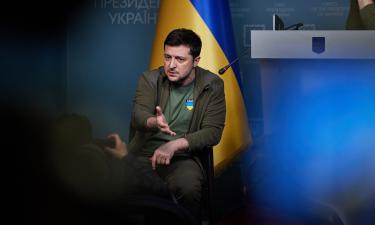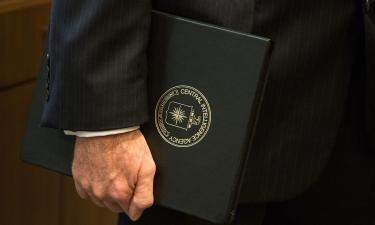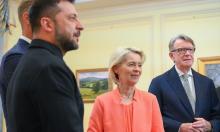A present from Bush to Moscow hawks
 The USA has taken several steps that could seriously complicate its relations with Russia and the rest of the world and drive on the race for nuclear weapons.
The USA has taken several steps that could seriously complicate its relations with Russia and the rest of the world and drive on the race for nuclear weapons.
First, President George Bush signed the Energy and Water Development Appropriations Act of 2004 that includes the allocation of budgetary funds for the creation of new types of nuclear weapons. One of them is small low-yield precision bombs that can provoke seismic tremors of the crust and annihilate reinforced military facilities - command centres, missile silos, missile and nuclear technical depots.
Second, the White House granted $24.9 to the Pentagon and the Department of Energy for the modernisation of the Nevada nuclear test site for underground nuclear tests.
And third, several days later the US defence department tested a sea-based ABM system that intercepted a ballistic missile in the first few minutes after the launch by hitting its warhead.
These three steps have greatly alarmed Russian military experts. "This is extremely dangerous for Russia," said Colonel-General Varfolomei Korobushin, first vice-president of the Academy of Military Sciences, who headed the General Staff's Centre for Operations and Strategic Studies from 1985 to 1990. "The thing is that the US navy deployed close to Russia's shores will soon have a chance to hit the strategic missiles launched from our submarines at the boost stage, thus making them absolutely useless weapons unable to fulfil their main task of ensuring deterrence from possible aggression."
General of the Army Andrei Nikolayev, Chairman of Defence Committee in the 3rd Duma, was even more forthright: "This step actually means that the USA has launched a new stage of the nuclear race." In the past few years, Russo-US relations have relied on a system of mutually binding treaties, which prevented either side from gaining a strategic advantage by delivering a first decapitating strike. Despite promises and the signing of the Strategic Offensive Reductions Treaty last year, the unilateral withdrawal of the USA from the 1972 ABM Treaty delivered a heavy blow to this balance. Generals usually assess not political positions, which can change depending on the situation, but real capabilities. If the Americans create precision guided penetration nuclear warheads with a yield of under 5 kilotons (as the White House-approved project provides for), this will render all Russo-US agreements senseless.
First, such warheads cannot be termed strategic and hence will not be covered by the SOR treaty limitations. Second, the USA will be able to place them at nuclear submarines armed with strategic missiles, approach Russia in the Sea of Norway or the Northern Sea and present an ultimatum to the Kremlin (like it did to Saddam Hussein). The flight time of such missiles will be 7-8 minutes. Technically, this is not enough to take a decision on a retaliatory strike or send an order to the launch sites. The precision guided penetration warheads will burrow into the crust, provoking seismic shocks and annihilating command centres and missiles in their silos.
Besides, such low-yield warheads can be mounted on US anti-missiles. Tests show that today the Pentagon can intercept one incoming missile by hitting its warhead with a kinetic (conventional) charge but it cannot intercept a group of missiles. This can be done only by a nuclear explosion, which was the basis of the ballistic missile system protecting Moscow for a long time. On the other hand, a high-yield nuclear explosion over national territory ordered to protect a large industrial or capital city always risks doing damage to other territories.
Low-yield nukes, even if exploded over national territory, do not do such damage, which means that the US ABM system will ensure maximum protection (90-95%). This impunity can turn the heads of some hawks in the US administration, giving them the chance to feel like the invulnerable rulers of the world, with all the ensuing negative consequences. This will make the future of Planet Earth extremely dangerous and unpredictable.
The line for creating low-yield nukes can have other dangerous consequences, say military experts. They cannot be created without underground nuclear tests. But as soon as the first such test is made at the Nevada site, Iran and other countries, in particular Argentina, Brazil, South Africa and a dozen of other threshold states, will rush to acquire their own nuclear weapons to protect their independence and sovereignty. This will effectively bury the nuclear club, where the USA, France, Britain, China and Russia are official members and India, Pakistan and Israel, unofficial ones.
The Moscow hawks are waiting impatiently for the USA to violate its nuclear test moratorium: Russian nuclear scientists have trial programmes, too. The Novaya Zemlya test site has been lying idle too long, they say. But not a single explosion occurred there while the Comprehensive Nuclear Test Ban Treaty was in force (though Moscow ratified it but Washington did not). If the USA carries out tests in Nevada, the Kremlin will not keep its defence industries from following the bad US example. They have been waiting too long since the end of the Cold War.
What else can the Russian hawks do in response to the resumption of nuclear tests in Nevada? Few people have noticed that there are quite a few of them in the 4th Duma (Gen. Makashov alone is worth a dozen). They can put serious and consistent pressure on President Putin and the Government to get additional allocations for the creation of ABM-evasion systems; low-yield prevision MIRVed missiles; new mobile strategic missiles which even precision nukes will be hard put to detect and hence destroy; new nuclear submarines; and the launch of additional reconnaissance, navigation and targeting satellites. This amounts to a new stage in the nuclear race, even though to the detriment of economic progress. But then, national security has always been a priority in Russia.
Late this week, Defence Minister Sergei Ivanov is expected to provide an official reply to Bush's decision to grant allocations to the creation of new types of nuclear weapons. A new regiment of Topol-M (SS-27) silo-based missiles will be put on combat duty in Tatishchevo outside Saratov, raising the number of the SS-27s to about 45. Today this is enough to deter a potential aggressor. As for tomorrow, both the Kremlin and the White House should give serious thought to it.
Viktor LITOVKIN, RIAN
Subscribe to Pravda.Ru Telegram channel, Facebook, RSS!




